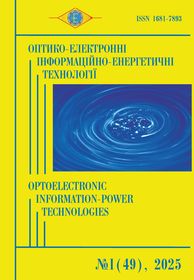Agile technology for developing an intelligent population development forecasting system
DOI:
https://doi.org/10.31649/1681-7893-2025-49-1-98-110Keywords:
data analysis, strategic planning and data forecasting, demographic data, decision making, machine learning.Abstract
The article is devoted to the development of an intelligent population forecasting system that uses machine learning methods to analyze historical demographic data. The paper considers modern challenges of demographic development that require accurate population forecasting for effective strategic planning. The article presents a description of demographic forecasting methods, formalization and mathematical models, such as linear and polynomial regression, as well as other models that can be used for forecasting. A machine learning model generation module has been developed that automates the process of building forecasting models based on historical demographic data. Data preprocessing functionality has been implemented, including automatic filling of missing values, data normalization and anomaly detection. Machine learning algorithms have been selected and integrated, quality assessment and model optimization have been carried out, and the possibility of retraining models has been provided. An interface for integration with other information systems has been developed. The results obtained demonstrate the flexibility and effectiveness of the proposed approach and the possibility of its use in the field of strategic planning of socio-economic development.
References
United Nations, Department of Economic and Social Affairs, Population Division (2022). World Population Prospects 2022: Summary of Results. United Nations Publication.
Gorelick, N., Hancher, M., Dixon, M., Ilyushchenko, S., Thau, D., & Moore, R. (2017). Google Earth Engine: Planetary-scale geospatial analysis for everyone. Remote Sensing of Environment, 202, 18-27.
Tableau Software. (2023). Tableau Public. URL: https://public.tableau.com/ (access date: 2023-11-24).
Ahmad, F., & Bashir, S. (2020). Population forecasting using machine learning techniques. International Journal of Advanced Computer Science and Applications, 11(10), 406-412.
Smith, S. K., Tayman, J., & Swanson, D. A. (2018). State and local population projections: Methodology and analysis. Springer.
Wilson, T., Raymer, J., & Rees, P. (2020). Methods of making national population projections: How well do they work? Population Studies, 74(1), 103-119.
Dergachev, V. A. (2020). Demographic processes in Ukraine and the world: challenges and development trends. Kyiv: Institute of Demography and Social Research of the National Academy of Sciences of Ukraine. 256 p.
UN. Sustainable Development Goals: Global indicators. [Electronic resource]. URL: https://unstats.un.org/sdgs/ (access date: 03.03.2025).
Libanova, E. M. (2019). Demographic processes in Ukraine: analysis and forecast. Kyiv: Institute of Demography, NAS of Ukraine. 340 p.
World Bank. (2023). World Development Report 2023: Demographics and Global Development. Washington: World Bank Publications. 380 p.
Russell, S., & Norvig, P. (2021). Artificial Intelligence: A Modern Approach. 4th ed. New Jersey: Pearson. 1152 p.
Hastie, T., Tibshirani, R., & Friedman, J. (2017). The Elements of Statistical Learning: Data Mining, Inference, and Prediction. 2nd ed. New York: Springer. 767 p.
Dubrova, O. S., & Kovalenko, I. V. (2022). Using Neural Networks to Predict Demographic Changes. Scientific Bulletin of Kyiv University, (3), 45–56.
Malinovsky, B. M. (2021). Economic and Social Aspects of Demographic Development of Ukraine. Economics and Forecasting, (2), 79–94.
Brynjolfsson, E., & McAfee, A. (2017). Machine, Platform, Crowd: Harnessing Our Digital Future. New York: W. W. Norton & Company. 416 p.
European Commission. Population and Demographic Trends in Europe. [Electronic resource]. URL: https://ec.europa.eu/eurostat (accessed: 03.03.2025).
United Nations. The Sustainable Development Goals Report 2023. [Electronic resource]. URL: https://unstats.un.org
Downloads
-
PDF (Українська)
Downloads: 45
Published
How to Cite
Issue
Section
License
Автори, які публікуються у цьому журналі, погоджуються з наступними умовами:- Автори залишають за собою право на авторство своєї роботи та передають журналу право першої публікації цієї роботи на умовах ліцензії Creative Commons Attribution License, котра дозволяє іншим особам вільно розповсюджувати опубліковану роботу з обов'язковим посиланням на авторів оригінальної роботи та першу публікацію роботи у цьому журналі.
- Автори мають право укладати самостійні додаткові угоди щодо неексклюзивного розповсюдження роботи у тому вигляді, в якому вона була опублікована цим журналом (наприклад, розміщувати роботу в електронному сховищі установи або публікувати у складі монографії), за умови збереження посилання на першу публікацію роботи у цьому журналі.
- Політика журналу дозволяє і заохочує розміщення авторами в мережі Інтернет (наприклад, у сховищах установ або на особистих веб-сайтах) рукопису роботи, як до подання цього рукопису до редакції, так і під час його редакційного опрацювання, оскільки це сприяє виникненню продуктивної наукової дискусії та позитивно позначається на оперативності та динаміці цитування опублікованої роботи (див. The Effect of Open Access).


